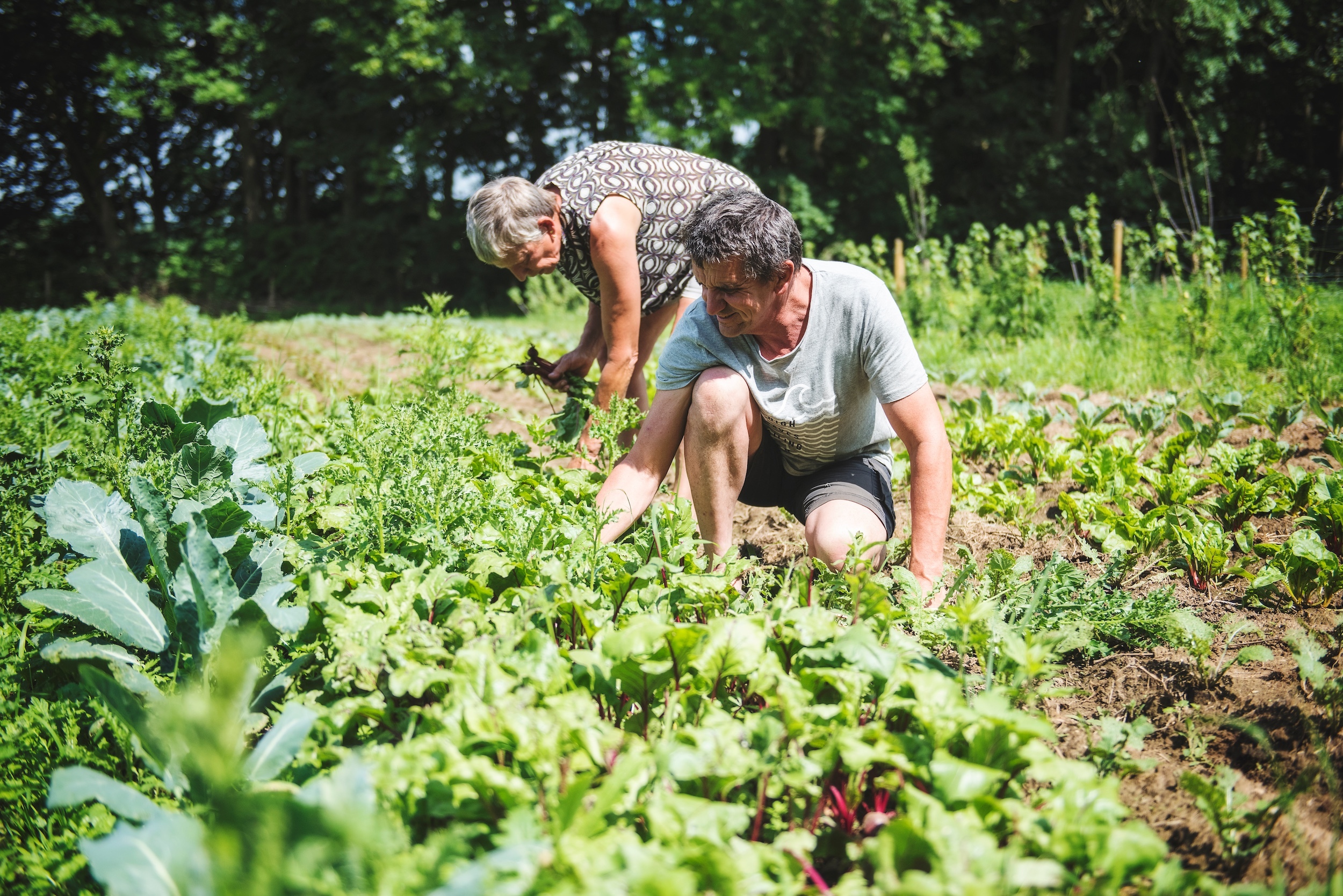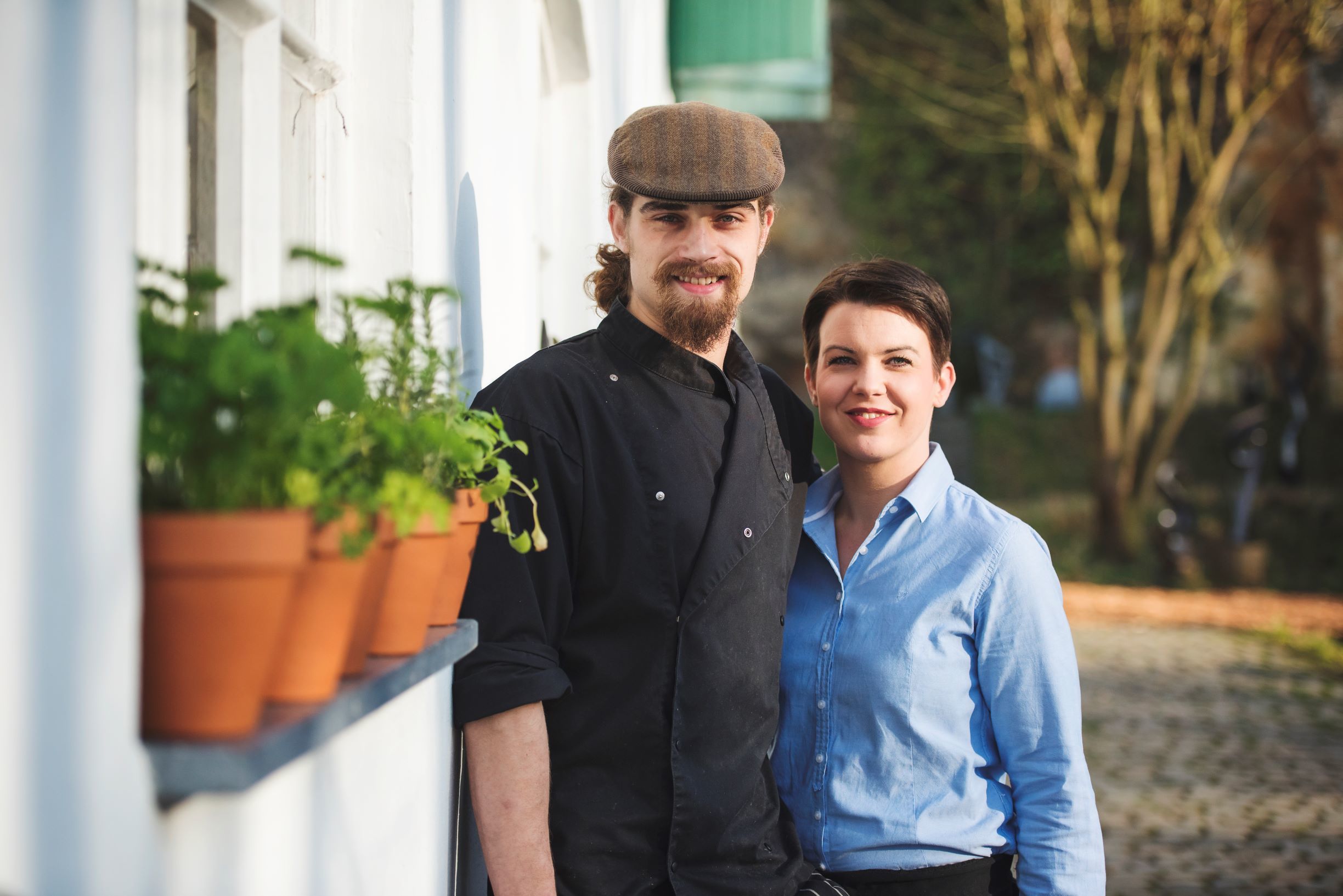Is he a farmer? A cook? A butcher? A shopkeeper? Yes, yes, yes and yes. Coenraad Reinders is all of these things. Together with partner Sanne Reinders-Essers, he runs Heerdeberg, a 17-hectare estate in Cadier en Kier, in the shadow of Maastricht. They keep pigs, cattle and geese, the meat of which is on the menu in the restaurant and sold in their own butcher's store. Mother José is the driving force behind the Buurderij Cadier en Keer, where consumers purchase dairy, vegetables, bread and other foods from regional producers. A food forest has been planted, mushrooms and chicory will soon be grown in the caves, and a permaculture vineyard is planned. In short: short chain and circular agriculture pur sang. The Kiempunt editors are curious: what motivates this agrofood entrepreneur to operate on so many fronts?
After studying automotive engineering, it was clear to Coenraad: this is not going to be it for me. He wants to go outside and work with animals instead of engines. He buys a few pigs and lets them roam around the estate. He sells the meat in a small store. "I didn't think about it that much, I just did it. I'm not someone who starts exploring all possible scenarios and then makes a decision. I start and then see what happens. It wasn't until I was named a five-star pig farmer by Varkens in Noord and one of the 100 food changemakers in the Netherlands that I realized: apparently I'm doing something right and it's getting noticed." It typifies his style of entrepreneurship: without fear, without a backup plan. With full conviction and an enormous dose of energy.
Farmer and cook at the same time
Since 2.5 years, Coenraad can be found more and more in the kitchen. "Between 7.00 and 10.00 in the morning I am working on the land. Taking care of animals, working the land, making fences, you name it. Then I spend the rest of the day in the kitchen of our restaurant. Sometimes a pig escapes and I have to leave. Weeks of 100 hours are no exception, but when you're 27, you can have that." The goal is to be almost completely self-sufficient within 10 to 15 years. Sanne adds: "We just don't have our own coffee, bread, dairy, fish and wine yet. Wine is the next thing we're going to work on. I'm taking a sommelier course right now, and we're going to build a permaculture vineyard that will be ready for harvest in 5 to 6 years. Right now people are still laughing at us. But just watch: by growing the vines together with certain herbs, you need little to no pesticides and we will soon have our own sustainably produced wine!"
Permaculture and food forest
Specialist Taco Blom brings his knowledge of permaculture and works several days a week with us on the estate. Under his care a vegetable and herb garden has been created according to permaculture principles. This means: no pesticides, but cleverly arranging the environment so that the pests are tackled by nature itself. The Bentheimers also provide the manure, eat the vegetable remains and plough the land. The garden on top of the plateau includes wild strawberry, quince, artichoke, celery, cauliflower and rhubarb, Chinese spinach and many herbs.
The cattle are moved regularly, so that they are always grazed, fertilized and turned over where necessary.
Coenraad: "I miss the knowledge and experience Taco has, so it is great to work with him, he really knows the craziest things! He provides an annual Permaculture training on the estate, so that others can also apply the principles. We would like more people to discover this way of growing food."
In addition to a garden, a food forest has been created with over 1,000 trees. Coenraad: "That is a matter of patience. In 10 to 13 years we will be able to harvest plenty of nuts and fruits. For now, we have to let nature do its work and let the forest grow. We are turning the situation around: we are not cutting down forest land and cultivating it into farmland, but we are upgrading farmland back to nature. Over time, the soil will become richer with microorganisms and natural cycles will emerge again. Eventually that will attract wildlife too, then it will even be possible to hunt here again!"

Taco Blom in the permaculture vegetable garden
Another meat
A pig lives two to three times longer at Heerdeberg than in the regular meat industry. "It almost has the color of beef and the taste cannot be compared to a ham steak from the supermarket. Because we produce for a niche market and I don't have to deal with middlemen, we can charge a relatively high price for that quality meat. Thanks to the restaurant, we can also tell the consumer the complete story and introduce them to less common parts of the animal." After completing a butcher's training course, Reinders plans to modify his butcher's store to accommodate large kettles and hang complete carcasses. That way, there will be room to make his own products like pâté and pastry.
Sanne: "It was really a struggle in the first years. Our concept was still being developed and not everyone understood what we wanted. And let's be honest, Limburg is not always at the forefront when it comes to these kinds of things. But as frustrating as that was, we stuck to our conviction and our story. We managed to attract an audience in our presentation that could actually appreciate what we do. The other day we hosted the event Butcher's Paradise, where an entire pig was boned. We let people taste the brains as an appetizer. That was a bit exciting, but it was well received. The next step is to put uncommon parts, such as bone marrow, on the menu. It is logical that people have to get used to a different way of dealing with food. Fortunately, we see that young families are also making their children aware of this. In this way a new generation is growing up that opts for sustainable and healthy food."
Old methods
With Blom's knowledge and Reinders' fresh perspective, there is once again ample room for the use of old farming methods. Not out of nostalgia, but out of practicality: it's just easier to let nature work for you. "In the past, caves were used for growing mushrooms and chicory, because the ideal conditions were there: dark and damp. We are going to do that again. I leave ploughing to the pigs. Geese eat the fruit flies. We are going to ensile cattle feed without using plastic. We can let a tree grow crooked; after 20 years it will be stronger and taller than if we had intervened. We do not weed the land; we make combinations of crops that prevent weeds or use livestock. We have started growing our own cattle feed. The basic principle is that we want to use everything, from the animal and from the land. The return is still uncertain, we are just at the beginning. It needs another 20 to 30 years to mature and that's not a bad thing. When I look out over the estate by then and see it flourish, I can say: we made this happen, just by letting nature take its course! In 80 years this estate will grow and flourish largely by itself. Then I will no longer be here, but I will leave something very beautiful for future generations."
Help farmers switch and consumers choose
Despite Coenraad's positive view of the future, he understands very well that large-scale farms that have been in business for some time and have made large investments cannot switch so easily to circular agriculture. "I don't believe that those 700 farmers really want to stop, they just don't see an alternative. Instead of buying them out, the government could also help them financially to make the transition possible. This would enable us to have more farms in the Netherlands practising closed substance cycle farming. In addition, something will have to change in the chain. Wouldn't it be nice if local farmers could supply their products to local supermarkets and if consumers could actually see which farmer supplied the potatoes and meat? Then the consumer can more easily exercise their power with the choices they make. I know it's complex, but we have to have the discussion about it if we want things to change."
Innovation tips from Coenraad Reinders
- Don't look and listen too much to others and certainly not to doomsday scenarios. Just start, and you'll find out what comes your way.
- Accept that nature is unpredictable. Sometimes you lose to nature, that's part of it.
- Look closely at what is happening around you, especially consumer behavior. For example, we stopped our monthly regional market because consumers were overfed with regional markets and started to purchase less and less. Now we organize a bigger event 4 times a year.
- Tough luck will come, but hang in there.Stay behind your own philosophy and look for the target group that does understand and appreciate that.
